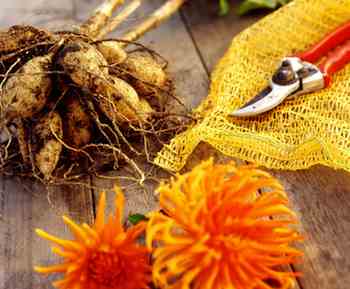By Sean Conway

Often mistaken as bulbs, tuberous roots are the key to the dahlias ability to thrive in extreme conditions.
Most plants in my garden are beginning to show signs that winter is not far off. Plants whose leaves were lush green just a few weeks ago are now yellowing or have already turned the color of a brown paper bag
One signal exception to the fading garden, however, are my dahlias, which favor the cool nights and warm days of fall.
Dahlias are native to the highlands of Mexico and Central America. There are 35 species found in the wild, and more than 20,000 cultivars. Their popularity is no surprise. Not only are they colorful additions to any garden, but they bloom prolifically as well, making them perfect cut flowers.
Dahlia flowers come in an array of colors, shapes, and sizes ranging from short daisy-flowered varieties suitable for the front of a border to gigantic "dinner plate" sized flowers that are the floral equivalent to giant pumpkins.
Dahlias are unusual in that they have eight sets of chromosomes where most plants have only two. This fact of nature is a hybridizer's dream, and it has led to the ever-increasing number of cultivars available to gardeners.
Easy to grow, dahlias are perennial in mild parts of the country, but they are not hardy in colder regions. Experienced gardeners know that dahlias are as prolific underground as above, producing an abundance of tubers. Often incorrectly referred to as "bulbs," dahlia tubers are enlarged roots similar to sweet potatoes.
These modified roots are storage devices for the plant, allowing it to set aside energy during times unsuitable for growth, such as dry periods or cool winter months.
Saving your favorite dahlias is easy. Not only can you keep plants from year to year, and save a few bucks in the process, but because they are so prolific, you can split them and give them away to friends and family.
Once your dahlias are hit by a light frost and the foliage turns black, cut the plant back leaving about 6 inches of stem above the ground. Compost the tops of the plants. Using a garden fork, lift the dahlia tubers out of the ground, taking care not to break them. Insert the garden fork about 1 foot away from the stem to be on the safe side. Once the first plant is dug, you can gage how close to insert the fork on the rest.
Some people prefer to wash any clinging soil from the tubers, but I prefer to lightly brush the soil off, avoiding any excess moisture before storage. Cut the stems back to about 3 to 4 inches, and be sure each clump has some stem attached to the tubers. Leave the tubers to dry in a bright, airy spot for a day, and then place them in bins or boxes filled with vermiculite or sand. I use horticultural grade vermiculite in old plastic milk crates lined with plastic bags to keep the vermiculite from spilling out. Store the tubers in a cool, dark spot that does not freeze until spring. Avoid storing your tubers near your furnace, as the warm dry air will cause shriveling.
I attach labels to the top of the stems so that, come spring, I remember which varieties are which. Bury the tubers with vermiculite so all parts are covered. The goal is to prevent air from drying the tubers out over the winter. Be sure to check the bins once or twice every 6 to 8 weeks. If the tubers appear soft and shriveled, sprinkle a little water into the vermiculite. If they are still firm to the touch, cover them back up and leave them alone. If any appear rotted like a bad potato, promptly remove them and discard to avoid the spread of disease.
When spring arrives and the soil warms, well after the danger of frost, plant the tubers back in your garden and enjoy your dahlias for another season.
Available at Amazon.com:
Trowel and Error: Over 700 Tips, Remedies and Shortcuts for the Gardener
Cut Your Energy Bills Now: 150 Smart Ways to Save Money & Make Your Home More Comfortable & Green
It's Easy Being Green: A Handbook for Earth-Friendly Living
Copyright © Cultivating Life by Sean Conway. All rights reserved.
AUTOS | HOBBIES | EDUCATION | FAMILY | FASHION | FOOD & RECIPES | HOME DECOR | RELATIONSHIPS | PARENTING | PETS | TRAVEL | WOMEN
Home & Garden - How to Save Your Dahlia Tubers Over Winter